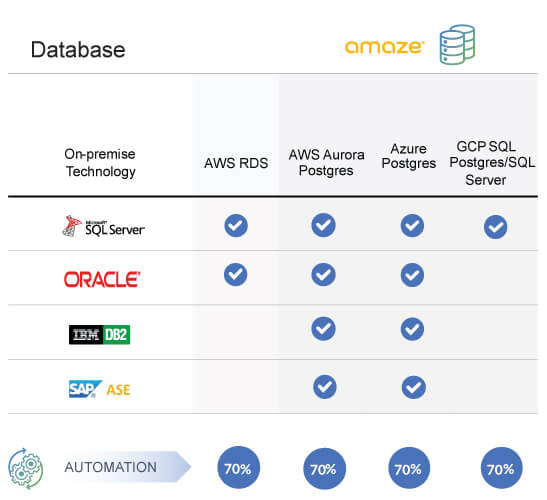Hexaware Acquires SMC Squared, a Leader in Building Global Capability Centers-Rolls Out GCC 2.0 Service Line. Learn More
This website uses cookies. By continuing to browse the site, you are agreeing to our use of cookies
A Guide to Application Modernization
Cloud
March 10, 2022
In this era of digital transformation, business applications are the backbone of any organization, driving essential business processes and helping to engage customers. Many of these applications are custom-built over time to support specific functions and enhance productivity. However, they often were designed using monolithic architecture and legacy technologies that are complex and expensive to support. The monolithic model focuses on a single integrated app, including most features and functions. There is a need to tailor experiences based on specific devices, users, and use cases in a real-world scenario. Application developers face many challenges once the application becomes vast and complex and struggle to manage an increasingly multifaceted landscape of applications, services, data, and APIs. The monolithic model limits today’s applications’ agility, flexibility, and scalability. Today, there is a need for applications that can scale rapidly to millions of users distributed globally, deliver great user experience, and manage millions of requests swiftly with very low latency. They need an application modernization strategy to stay agile.
Hexaware’s class-leading automated application cloud modernization platform ‘amaze®’ enables you to truly modernize your Java, .NET, and TIBCO applications rapidly and helps to tackle all the major challenges in the journey by adopting application modernization best practices. Before we discuss how amaze® does this, let’s understand application modernization in detail.
What does Application Modernization Mean?
Application modernization is the constant transformation of legacy software to a new application or platform, including more unique languages, frameworks, libraries, tools, architecture, and infrastructure. The modernization options include replatforming, rehosting, recoding, rearchitecting, re-engineering, interoperability, etc. Application leaders are looking for an end-to-end app modernization approach for retiring low-usage applications, replacing SaaS applications, lifting and shifting to the cloud, refactoring, optimizing with cloud PaaS or containers, or rebuilding with cloud-native architectures. With the rise of the low code approach, many organizations also extend their existing LOB apps or rebuild them with cloud-based low-code solutions. Here are some examples of application modernization architecture, tools, and technologies:
- Cloud native computing- It refers to migrating legacy applications to run in modern cloud environments. Even though it does not remove the need for a server, it outsources software code from the cloud service provider.
- Containers and Kubernetes- It is a cloud-centric method for packaging, deploying, and operating applications and workloads. It enables the design of scalable and consistent applications well-suited for cloud infrastructure, especially multi-cloud and hybrid cloud environments.
- Monolith to microservices- The concept is to split the application into a smaller set of interconnected services. Each service focuses on a particular function, such as payment processing or authentication and notification. Each microservice is a different unit with a separate codebase, infrastructure, and database.
From our vast experience in providing contemporary application modernization services to firms of all sizes (which also include a few Fortune 500 ones), most cloud journeys get stuck in the middle mainly due to unanticipated challenges resulting in inflated IT spends. One of the key reasons may be incorrect cloud readiness assessment and lack of planning. Amaze®’s intelligent automated assessment engine not just assesses your application for cloud modernization but also suggests a suitable roadmap along with the cost savings you may realize once the application is migrated to cloud.
Challenges that you Need to Deal with for Successful Application Modernization
As we know, application leaders must deal with a complex application landscape, including manifold technologies, frameworks, and infrastructure, overlapping business processes, and dependencies from
hard-coding integrations. Organizations also face challenges related to cultural change in IT mindset, upgrading IT and development skills, and the cost incurred. Here are some critical challenges that application leaders face and often struggle to determine where and how to start the application modernization process.
- Legacy application and dependencies – Legacy applications and their components like data, network configurations, and security are tightly coupled with the underlying infrastructure. This tight integration makes upgrading application components tricky. Even minor updates can be slow and require a lot of effort and time.
- Siloed application and testing- With time, organizations see applications duplicated with different users or departments based on their needs. This results in running the same application on additional infrastructure with other databases and doubling maintenance effort for the IT staff. The siloed application scenario makes application testing more complicated and makes it challenging for IT teams to optimize and consolidate applications and infrastructure.
- Lack of knowledge and skills– There is a shortage of developers that understand the legacy application technology stack and create comprehensive functional and technical gap analysis for the required application modernization. Most of the source codes in the legacy applications are highly patched and developed over the years without proper design documents. Thus, the developers need to review the codes manually. This is an enormous task and requires a lot of knowledge, skills, effort, and time.
- IT and business misalignment- In many organizations, business groups and IT departments face misalignment on application goals, thereby resulting in many apps and data stores having overlapping functionality or being redundant. In this misalignment, application modernization is challenged with critical aspects like time-to-value, the total cost of ownership, and user experience. This leads to higher costs, inefficiency, and a lack of integration of business processes.
- Migration issues and business impact– There are a lot of challenges when migrating and transforming applications to newer platforms or architecture. You need to ensure that the migrated apps work as expected in the newer environment without any business impact. During migration, there might be some cut-off due to high complexity and dependencies, and you need to ensure that there is no subsequent impact on the overall business functioning and processes.
Amaze® is based strongly on Hexaware’s principle of automation-first and helps you to tackle all these challenges strategically by adopting maximum automation. This also eliminates your dependency on SMEs to understand on-premises legacy applications as amaze® can analyze your application architecture and technology stack automatically without any manual intervention.
Application Modernization Benefits
A comprehensive application modernization strategy can help overcome the typical challenges in the journey (we will talk about these in the next section). With effective application modernization tactics, you need fewer resources to develop, operate, and maintain the application while increasing the application’s reliability, resiliency, and uptime. Your applications can achieve scalability, gain reliability and performance, and enhance user experience with application modernization. Application performance gets better and new feature delivery becomes faster. Application modernization results in performance gains and reduces the time and effort needed to update apps. An application and its associated components can be developed and deployed rapidly in process-driven ways along with mitigating the risk of support loss in legacy software environments. With augmented user experiences, application modernization improves employee productivity and opens new business opportunities.
Get a winning edge with Amaze® for application modernization to the cloud
- Migration of legacy apps to the cloud in just 6-8 weeks
- More than 50% cost savings
- 50% faster cloud migration
- 25% more development productivity
- Leverages open-source platforms and thus, eliminates major licensing costs
- API-led integration for seamless performance and optimal user experience
- Containerization of app as macro/micro services
- No change in business functionality of the application post cloud migration
Application Modernization Approaches
App modernization tends to start small and build confidence over time. So, there is no minimum number of qualified apps to get started. No two applications can be identical; their requirements vary based on the function, user experience, integration with other apps, database, architecture or deployment, or other aspects. For any application modernization, you need to understand the infrastructure behind each app in its current architecture. Your application modernization approach depends on factors like the complexity of the application, application dependencies and the required infrastructure, team skillset, and many more. To help you come out with the vast array of app modernization descriptions, Gartner describes the below options for application modernization.
- Rehost- Also known as lift-and-shift, rehost means taking an existing legacy application and moving to newer modern infrastructure, such as a public cloud platform. This strategy involves shifting your physical servers and VMs to the cloud just as they are and gaining the benefits of cost savings, security, and increased reliability. In this context, the current hardware and operating systems are managed by the cloud provider once the shifting is completed. The other aspects of the workload or application management and operations remain the same.
- Refactor- Refactoring means rewriting, restructuring, or repackaging. This strategy involves taking a legacy application and revising significant portions of its underlying code to run better in a new environment and optimize cost, reliability, and performance. With minor code or configuration changes, you continue to use your current application as-is and connect the app to new infrastructure services like containers, database, and identity management systems.
- Rearchitect- Also known as redesigning, this strategy involves rearchitecting an application and transforming it with a modular architecture. It means modifying or extending an existing application’s codebase to optimize it for a cloud platform for better scalability and reliability. It is the most time-consuming way to migrate an app to the cloud because it requires app code changes. One example of rearchitecting would be decomposing a monolithic application into microservices that work together and scale readily on the cloud.
- Rebuild- It involves rebuilding the existing application by adopting cloud PaaS or even SaaS services and architecture. This means rearchitecting the application for the cloud. An example of rebuilding would be redesigning code to decompose the original application into smaller chunks and then deploying using modern cloud services.
- Replace- It involves discarding an existing application and replacing it with a commercial cloud software delivered as a service (SaaS). In this strategy, all the underlying infrastructure, middleware, app software, and app data are managed by a service provider with an appropriate service agreement, ensuring the availability and security of the app and its data.
Amaze® provides end-to-end cloud modernization solution, right from assessment till deployment and
post-deployment support. It helps you to choose the right strategy based on the target state of the application and makes decision-making easy and futuristic along with enormous cost reduction.
Application Modernization Best Practices
Here are some of the best practices to help an organization in its journey to application modernization.
- You must create a compelling business case for application modernization by finding answers to questions like why do you want to modernize an application now, what are the associated benefits, what are the risks in the process, and what are the new business opportunities that it opens?
- Create success metrics to measure and evaluate your success. Also, it is nice to have a risk assessment model for each migration or application modernization approach (refactor, rehost, rearchitect, rebuild, or replace). Document all the details and aspects of the journey for future growth and opportunity.
- Create a detailed roadmap for application modernization. The roadmap should include all the aspects, including assessing the current IT infrastructure (number and nature of servers, network configuration, storage, etc.), time and effort needed to create the required infrastructure, and whether the target cloud environment supports it.
- Consider an approach to isolate your applications from the infrastructure, including database network configurations and security configurations. With this approach, you can run your application component anywhere by using different underlying infrastructure combinations. You would need to make your application portable so that it can run in any environment without any code and avoids vendor lock-in.
- Consider application migrations to the cloud. Consider creating virtualized or containerized application environment using open source and other tools and APIs that makes this approach possible to implement at scale. This would also help you manage your applications at a specific component level, and you can run and test the application efficiently and effectively in a virtual environment.

Amaze® enables rapid modernization of legacy applications by offering the right blend of modern technology stack, automation, and best practices. It provides customized solutions to migrate Java, .NET, or TIBCO BW
on-premise applications with Oracle, DB2, or Sybase database to a suitable open-source platform on any private/public/hybrid cloud of your choice. We have partnered with hyperscalers like AWS, Azure, and GCP to gain maximum cloud advantage for our customers without compromising on security.
Developing An Application Modernization Business Case
Application leaders often find it challenging to develop a compelling business case for modernizing the application portfolio. When building a business case for application modernization, you need to focus on a few areas like problem identification, migration path, technology assessment, project cost and timing, and business value justification (cost-benefit analysis).
- Document the problems you are facing in the existing applications and detail all the pain points, concerns, or issues you are trying to resolve. You need to create relatable, simple, and
easy-to-understand reports that any non-technical person can understand. - Develop a vision and correlate the transition from the current state to the desired Cover all the aspects regarding the inappropriateness of existing business processes and technology advancements through new trends and understand how these trends and technologies can make your business process and functions more effective and efficient.
- You need to create a project report with cost estimation, timelines, resources required, and checkpoints. The report should include the number and types of applications or databases and the time and resources needed to complete the transition.
- Develop business value analysis and cost-benefit analysis that defines the business impact. Also, refer to the applicable business metrics that help you monitor and report the effects during execution.
Modernizing Applications with Microsoft Azure
Azure offers multiple options for hosting your application like Infrastructure-as-a-Service (IaaS),
Platform-as-a-Service (PaaS), Containers-as-a-Service (CaaS), and serverless. It provides you with the flexibility to opt for a cloud journey that best suits your business needs. For example, suppose you are opting for the replatforming approach for your ASP.NET sites, you can use Azure App Services. Or, if you are rearchitecting your legacy application to microservices/containers, you can use Azure Kubernetes Service (AKS). Azure App Service is a purpose-built platform for running web-based applications. It supports all the standard frameworks and you can also run your containerized applications using custom Windows or Linux containers. AKS helps you run your containerized applications when you want more control over your infrastructure. The app containerization tool offered by Azure helps you to containerize and migrate apps quickly to AKS. Azure Migrate services can be used to discover, assess, rightsize, and move applications, databases, and infrastructure to Azure. Also, there are Azure DevOps services to help developers work, collaborate on code development, and build and deploy applications faster.
Modernizing Applications with AWS
You also get various options for hosting and modernizing applications in the AWS cloud. If you are thinking of moving your applications to a container-based environment, you can replatform those workloads to AWS managed services like Amazon Elastic Kubernetes Service (Amazon EKS), or Amazon Elastic Container Service (Amazon ECS) with AWS Fargate. You can build new, secure apps on serverless architecture by adopting container services like Amazon ECS and Amazon EKS or event-driven serverless compute services like AWS Lambda. Customers choose AWS Lambda when teams focus primarily on writing code and have no limitations on the existing instances or container platforms. AWS Lambda offers maximum abstraction from infrastructure and thus, enables customers to execute releases faster. Therefore, new applications are a great fit for AWS Lambda. You can automate provision, publish, and instantiate code to production through AWS DevOps and continuous integration and deployment (CI/CD) practices.
Amaze® transforms legacy on-premises apps and the related databases to cloud native applications on AWS/Azure/GCP by using the features below:
- Cloud modernizes your portfolio applications to cloud native applications
- Refactors your applications to enable higher scalability and availability on the cloud
- Enables seamless integration with cloud PaaS solutions through API-enablement
- Replatforms commercial middleware and databases to Azure/AWS cloud DBaaS/PaaS



Don’t Miss the Cloud Bus when Amaze® is at the Wheel!
Application modernization is inevitable to drive digital transformation. When modernizing your application, you need to be confident about the business and technical value it brings to your organization. Hexaware’s amaze® can help you accelerate the application modernization journey and realize unique transformation goals with strategic execution and project management. Our end-to-end solutions covering replatforming, rearchitecting, or re-engineering legacy apps have been recognized by many leading analysts. To explore more about amaze®, reach us at amaze@hexaware.com
About the Author

Praveen Chhangani
Read more
Related Blogs

Understanding Snowflake Cortex for Gen AI Applications with Sensitive Data
- Generative AI
- Cloud
- Data & Analytics

Ready to Pursue Opportunity?
Every outcome starts with a conversation
















